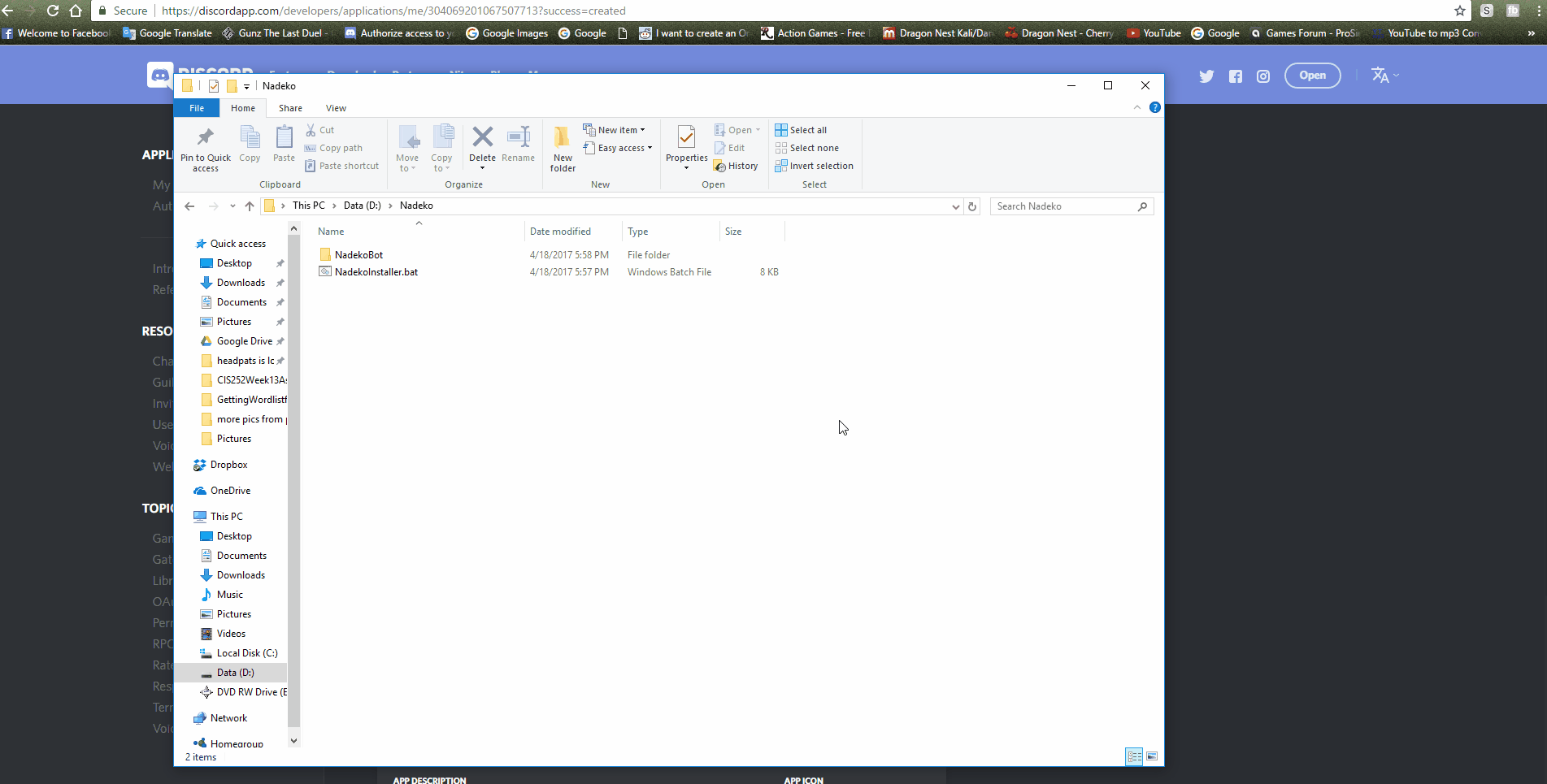Setting up your Credentials
If you do not see credentials.json you will need to rename credentials_example.json to credentials.json.
This is how the credentials.json looks with all the APIs:
{
"ClientId": 179372110000358912,
"BotId": 179372110000358912,
"Token": "MTc5MzcyXXX2MDI1ODY3MjY0.ChKs4g.I8J_R9XX0t-QY-0PzXXXiN0-7vo",
"OwnerIds": [
105635123466156544,
105635123566156544,
105635123666156544
],
"LoLApiKey": "6e99ecf36f0000095b0a3ccfe35df45f",
"GoogleApiKey": "AIzaSyDSci1sdlWQOWNVj1vlXxxxxxbk0oWMEzM",
"MashapeKey": "4UrKpcWXc2mshS8RKi00000y8Kf5p1Q8kI6jsn32bmd8oVWiY7",
"OsuApiKey": "4c8c8fdff8e1234581725db27fd140a7d93320d6",
"Db": null,
"TotalShards": 1
}
Creating Discord Bot application

- Go to the Discord developer application page.
- Log in with your Discord account.
- On the left side, press
New Application. - Fill out the
App Name(Your bot's name, in this case) - Put the image if you want, and add an app description. (Optional)
- Create the application.
- Click on
Create a Bot Userand confirm that you do want to add a bot to this app. - Keep this window open for now.
Inviting your bot to your server

- Invite Guide
- Copy your
Client IDfrom your applications page. - Replace the
12345678in this link:
https://discordapp.com/oauth2/authorize?client_id=12345678&scope=bot&permissions=66186303with yourClient ID. - The link should now look like this:
https://discordapp.com/oauth2/authorize?client_id=YOUR_CLENT_ID_HERE&scope=bot&permissions=66186303 - Go to the newly created link and pick the server we created, and click
Authorize. - The bot should have been added to your server.
Setting up credentials.json file

- In your Discord applications page, under the
Bot Usersection, you will seeToken:click to reveal, click to reveal the token.
Note: Make sure that you actually use a Token and not a Client Secret! It is in the App Bot User section. - Copy your bot's token, and on the
"Token"line of yourcredentials.json, paste your bot token between the quotation marks.
It should look like:
"Token": "MTc5MzcyXXX2MDI1ODY3MjY0.ChKs4g.I8J_R9XX0t-QY-0PzXXXiN0-7vo",
- Copy the
Client IDon the page and replace the12312123part of the"ClientId"line with it.- Important: Bot ID and Client ID will be the same in newer bot accounts due to recent changes by Discord.
- If that's the case, copy the same client ID to
"BotId"
It should look like:
"ClientId": 179372110000358912,
"BotId": 179372110000358912,
- Go to your Discord server and attempt to mention yourself, but put a backslash at the start like shown below:
(to make it slightly easier, add the backslash after you type the mention out) - So the message
\@fearnlj01#3535will appear as<@145521851676884992>after you send the message. - The message will appear as a mention if done correctly, copy the numbers from the message
145521851676884992and replace the ID (By default, the ID is105635576866156544) on theOwnerIdssection with your user ID shown earlier. - Save
credentials.json - If done correctly, you are now the bot owner. You can add multiple owners by seperating each owner ID with a comma within the square brackets.
For single owner it should look like:
"OwnerIds": [
105635576866156544
],
For multiple owners it should look like:
"OwnerIds": [
105635123466156544,
105635123566156544,
105635123666156544
],
Setting up your API keys
This part is completely optional, However it is necessary for music and few other features to work properly
- GoogleAPIKey
- Required for Youtube Song Search, Playlist queuing, URL Shortener and lot more.
-
Follow these steps on how to setup Google API keys:
- Go to Google Console and log in.
- Create a new project (name does not matter).
- Once the project is created, go into
Library - Under the
Other Popular APIssection, enableURL Shortener APIandCustom Search API - Under the
YouTube APIssection, enableYouTube Data API - Under the
Google Maps APIssection, enableGoogle Maps Geocoding APIandGoogle Maps Time Zone API -
On the left tab, access
Credentials,- Click
Create Credentialsbutton, - Click on
API Key - A new window will appear with your
Google API key
NOTE: You don't really need to click onRESTRICT KEY, just click onCLOSEwhen you are done. - Copy the key.
- Click
-
Open up
credentials.jsonand look for"GoogleAPIKey", paste your API key inbetween the quotation marks.
It should look like:
"GoogleApiKey": "AIzaSyDSci1sdlWQOWNVj1vlXxxxxxbk0oWMEzM",
- MashapeKey
- Required for Urban Disctionary, Hashtag search, and Hearthstone cards.
- You need to create an account on their api marketplace, after that go to
market.mashape.com/YOURNAMEHERE/applications/default-applicationand press Get the keys in the top right corner. - Copy the key and paste it into
credentials.json
- LOLAPIKey
- Required for all League of Legends commands.
- You can get this key here
- OsuAPIKey
- Required for Osu commands
- You can get this key here.
You will need to log in and like the soundcloud it may take a few tries.
- TotalShards
- Required if the bot will be connected to more than 1500 servers.
- Most likely unnecessary to change until your bot is added to more than 1500 servers.
DB files
SCBot saves all the settings and infomations in NadekoBot.db file here:
NadekoBot\src\NadekoBot\bin\Release\netcoreapp1.1\data\NadekoBot.db (NadekoBot v1.4x)
in order to open the database file you will need DB Browser for SQLite.
To make changes
- Copy the
NadekoBot.dbto someplace safe. (Back up) - Open
NadekoBot.db - go to Browse Data tab
- click on Table drop-down list
- choose the table you want to edit
- click on the cell you want to edit
- edit it on the right-hand side
- click on Apply
- click on Write Changes
and that will save all the changes.
